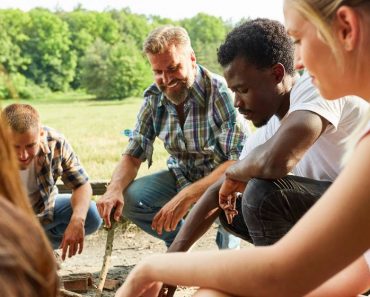Survival Ordeal of Uruguayan Air Force Flight 571
The plane chartered by the Old Christians rugby club to fly from Montevideo Uruguay to Santiago, Chile after a stopover in Mendoza, Argentina. It was piloted by the flight’s inexperienced copilot Lt Col Dante Héctor Lagurara. Thinking he had flown past Curicó, and had flown over the Andes, he turned north toward Santiago and began the decent. When he regained visual navigation, he could plainly see the Andes towering in front of him, telling him that he hadn’t overflown Curicó and had made the turn prematurely. He tried to gain altitude, but it was too little too late and all he could do was to control the plane’s crash landing in the mountains. (Wikipedia, 2024)
The premature turn put the plane far to the north of its filed flight path. Unable to locate the plane in 8 days, the search ended. Human error had caused a plane crash that stranded an amateur rugby team at 11,710 feet (3,570m) in the Andes Mountains. Still, the pilots managed to bring the plane down with 33 survivors, 7 missing and 5 fatalities, including the pilot.


Another 5 died from the injuries or the combined effects of their injuries and exposure during the first night. By day 12, 6 more would die. An avalanche killed 8 more on day 17.
Imagine a bunch of traumatized, entitled jocks freezing and starving to death for two months in a sardine can as they solved the problems of survival and wrestled with the morality and taboos of eating their dead friends to stay alive. There was a lot of selfishness, arguing, cursing, blaming, and drama, like the Andes edition of Lord of the Flies. They fought over everything … whether a particular plane saw them or not, whether rescue was on the way, whether it was okay to eat all the food since rescue must be on the way, and of course, some felt like the rules didn’t apply to them and did what they wanted. Then the others wanted to kill them for endangering everyone else with their gluttony … and on and on it went.
Reading ALIVE was exhausting. I’m sure the childish drama must have been as exhausting as the exposure to the cold and the hunger to those who lived through it. Still, there are lessons to be learned from these young survivors.
Lessons Learned
Sometimes Survivors Must Affect Self-Recovery Instead of Waiting for Rescue
If you read books and articles on survival, you’ve undoubted read expert advice telling you to “Always stay with the aircraft or vehicle!” and “Never try to walk out!” When you’ve read many thousands of such books and articles, as I have doing research on the subject, you hear the same advice repeated endlessly.
If Nando Parado and Roberto Canessa had followed that advice, there would have been 45 bodies up on that mountain instead of 29. If you think that this outcome is rare in the extreme, I beg to disagree. It’s usually, but not always, the right course of action.
So, where does the fundamentalist paradigm “NEVER leave the crash site.” come from? It comes from exhausted SAR personnel who spend tons of energy tracking down lost outdoorsmen. They are activated over and over to handle similar scenarios so similar they feel like they’re in Groundhog Day.
So, if everybody knows this, why are virtually all the SAR calls the same? “Lost idiot didn’t stay put, so we had track them all over creation.” One must understand the psychology the survivor is experiencing, and that the SAR personnel don’t see every survival ordeal, just the ones where someone doesn’t make it back on their own.
The survivor sets out thinking they have a clear destination in mind. They are thinking, “Salvation is just around the next hill or bend in the trail.” It becomes a problem when they don’t head back as soon as they realize that’s not the case. Instead of treating their self-recovery plan as a direction sampling search and traveling along the same bearing for a given amount of time and then retracing their trail back to their vehicle, crash site or the point where they realized they were lost, they keep walking.
I wrote that the SAR personnel only get the calls where someone doesn’t make back on their own. If you are an outdoorsman, how many times have you been delayed or stranded? If you out much, it’s probably happened. You went out hunting and got cut off by a flash flood, your vehicle got stuck and you had to spend the night and dig it out in the morning or simply are unable to self-extricate, your vehicle broke down, you got turned around, these are all examples. Now, how many times did you call Search & Rescue? If you’re like most outdoorsmen I’ve asked these questions, you have run into problems many times, but never called search and rescue. You were reasonably well prepared and successfully affected self-recovery. And because you never called, all those incidents were not reported or tracked. In fact, most survival ordeals end this way.
Survival ordeals like “The Miracle in the Andes”, are rare, not because affecting self-recovery is impossible, but because long-term survival ordeals are rare and long-term survival ordeals where SAR is activated, fails to find the survivors, the search is called off, and then the survivor’s affect self-recovery, is rarer still, but are not unheard of. In fact, one might be surprised how many epic survival ordeals end in self-recovery. Shackleton’s failed expedition to the South Pole only ended after they trekked to the edge of the ice sheet, sailed lifeboats to Elephant Island where the expedition camped while a small group sailed 800 miles to South Georgia Island and then trekked overland to the whaling station. Salvador Alvarenga’s 438 days adrift in the Pacific ended only when his boat beached in a small atoll in the Marshall Islands where he climbed out and found some locals. Slawomir Rawicz escaped from a Russian POW camp in Siberia and trekked 4,000 miles south through the Gobi Desert, through Tibet, and over the Himalayas to British controlled India. In 1823, Mountain man Hugh Glass was left for dead, without his rifle or eqiupment, after being mauled by a grizzly. Glass crawled, hobbled, and rafted 200 miles to Ft Kiowa in 6 weeks, subsisting principally off roots and berries.
As you research the epic survival ordeals, you might be surprised how many are more self-recovery than rescue. In the end, taking a fundamentalist approach to survival is less effective. Survival is about adapting and knowing when to follow the rules and when to take the stairs down even though the port authority is telling you to shelter in place in the World Trade Center. There are times when you should stay put and signal for rescue and there are times when you should affect self-recovery. When you hear over the radio that the search has been called off, as the Old Christians Rugby Club did, it’s time to execute your self-recovery plan.
Adapt and Overcome
The other big takeaway from this survival ordeal is number of adaptations they engineered from the wreck to survive in the extreme cold high in the Andes.
Not all of their attempts to adapt solutions were successful. They tried to get the aircraft’s radio working by retrieving batteries from the tail section and connecting them to the radio in the cockpit but were unsuccessful. They also attempted to write SOS on the fuselage using lipstick and nail polish but soon realized the letter would not be anywhere near large enough to be seen from the air.
Not everything survivors try works. They make mistakes, learn from them, try something else, and don’t give up. Had someone had a small bottle of potassium permanganate, they could have added it to water at little at a time and used the resulting bright pink/red/purple dye to stain the snow creating large letters whos’ color would have stood out against the black and white mountains.
Adaptations
Here are some of the many adaptations the team used to survive in the unforgiving environment above the tree line in the Andes:
- Solar Snow Melters – Adolpho “Fito” Strauch solved the problem of melting snow with aluminum sheeting. Each seatback had a rectangle of the material inside it which measured approximately 1’ x 2’. Once removed, they could be formed into a shallow basin with a pour spout, filled with ice and snow, and set in the sun to melt. Bottles were positioned under the spouts to catch the meltwater.
- Blankets – They improvised small blankets from seat covers.
- Hammock – The interior of the plane could be converted to carry cargo and had webbing that locked into hard points in the 8’ x 10’ section of fuselage used as a shelter for 28 survivors. They used these to fashion a hammock, effectively increasing the real estate inside the shelter of the fuselage.
- Radio Antenna – They fashioned a radio antenna from electrical wire for use with an AM transistor radio, which they used to receive broadcasts, including the news that the search had been called off. This news was instrumental in the decision to walk out on their own.
- Inventoried and Rationed Food – Rationing extended the food supply and reduced the shock to their bodies.
- Snowshoes – Snowshoes were improvised from seatbelts and foam from seats. They required an awkward bowlegged stride but enabled survivors to walk on the crust of the snow.
- Sunglasses – With only three pairs of sunglasses to prevent snow blindness, Fito Strauch also improvised sunglasses from green plastic sunglasses in the cockpit, holding them in place with elastic bra straps sewn to the plastic with electrical wire.
- Eating the Dead – If they hadn’t eaten the dead or walked out, everyone on the flight would have perished. Initially revolted, they could eat only skin, muscle and fat but eventually added hearts, lungs, and brains to the menu.
- Sun-Drying Meat – Without any means to cook the human flesh they used to sustain themselves, they sun dried it as well as they could. This is a smart move because both pasteurization and the removal of water reduce the pathogen load.
- Sleeping Bag – For the attempt to walk out, they fashioned an expedient sleeping bag out of insulation from the rear of fuselage, and a waterproof covering from the AC unit, sewn together with electrical wiring.
- Throwing the Note Over the River and Pantomime – When Roberto Canessa and Fernando Parado finally ran into ranchers on horseback, the men were on the other side of a river, the noise from which, prevented verbal communication. It these situations, the survivors are often unable to convince the other party they are need rescue. To their credit, the boys fell to their knees as if in supplication. The rancher eventually tied a note to a rock and threw it across the river, then a pen, making communication possible. (Read, 1974)
Sometimes You Have to Eat Your Friends to Survive
Taboos are powerful and survivors often must break them to stay alive. My wife told me she won’t ever kiss me again if I eat another snake. Imagine if I ate my Rugby buddy.
The first group of rescue helicopters was guided to the crash site by Nando Parrado. Unable to land due to deep snow, it set one skid on the ground and three Andinists (the South American version of an Alpinist) and a medical orderly got off (and unloaded some gear) to stay with the group, and six survivors climbed aboard. Poor weather conditions preventer further rescues that day, so the helicopters would return the following day.
The Andinists photographed the scene, including evidence of cannibalism, telling the survivors (who objected to the photos) that the photos were for military records and would never be published. I’m sure you can guess what happened next. The Andinists leaked the photos, and they were front page news on tabloids the world over.
Sadly, these young people had to make the tough decision to eat people they knew to live, up on that mountain, in the cold, and people sitting in the comfort of their homes judged them for it. So, in addition to the post traumatic stress that comes from surviving and ordeal with so much suffering and loss of life, and psychological difficulties of dealing with the anthropophagy that occured, they had to deal with unfair and very public criticism. I’m sure it was hard enough for the families to handle, especially those who lost children and then had to deal with the fact that they had been consumed by their friends. But to have them unfairly attacked in the world press was unfair.
Works Cited
Read, P. P. (1974). ALIVE. New York: Avon Books.
Wikipedia. (2024, April 15). Uruguayan Air Force Flight 571. Retrieved from wikipedia.org: https://en.wikipedia.org/wiki/Uruguayan_Air_Force_Flight_571






![[VIDEO] Transforming an LMTV into the Ultimate Bugout Overlander – Part 5 [VIDEO] Transforming an LMTV into the Ultimate Bugout Overlander – Part 5](https://survivalcove.com/wp-content/uploads/2023/02/lmtv_article_edited-370x297.jpg)




















